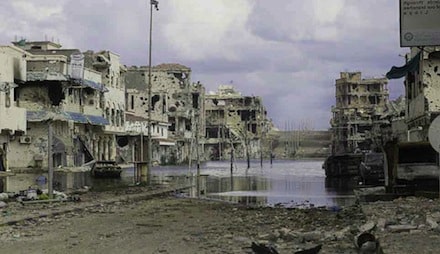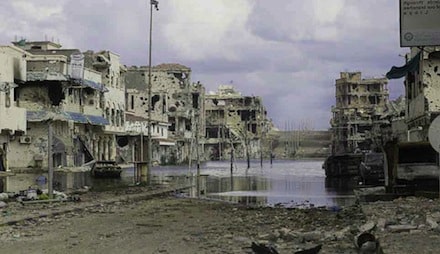
America doesn’t want to know what happens in its wars. It wants to believe each war starts in righteousness, usually something as lofty a goal as freeing people from oppression or bringing them democracy. It then wants to believe our side is clean, as any force of righteousness must be. And then at some point it wants to forget about it all absent a few Business Class upgrades for soldiers flying home next week over Thanksgiving. But what happens when the truth, the overriding truth bigger than a single atrocity, peaks out from under the heavy cover of lies?
You may remember America went to war in Syria in 2015 under Barack Obama. What was going to happen next there was a major campaign issue in 2016. The catch-phrase was whether either candidate supported “boots on the ground.” Trump, who did not overtly support that, did it anyway, and under now a third president some 900 Americans are still on the ground in Syria on a mission looking for a strategy. It would be surprising if one out of 100 Americans knew today we were still at war in Syria. Don’t ask Senator Tim Kaine, Clinton’s running mate in 2016. During a recent Senate hearing on Afghanistan, he declared, “I am relieved that for the first time in 20 years, children being born in this country today are not being born into a nation at war.” It is doubtful Kaine or more than one out of ten thousand when told of the ongoing fight in Syria could explain why.
So it is surprising to see the New York Times front page an investigation into a more than two year old US air attack in Baghuz, Syria which killed some 80 women and children. Though the entire strike was preserved on drone video, a precise death count is unlikely because the three weapons dropped, totaling over 2,500 pounds of explosives, would have reduced most of the dead to a fine, pink mist. Hard to count that. The amount of explosives used against these undefended human targets in the open was roughly the equivalent of that carried by a B-25 into actual combat during WWII.
The rest of the Times’ story is much the same story. The 2019 Baghuz strike was one of the largest civilian casualty incidents of the war, but was never been publicly acknowledged by the US A military legal officer flagged the strike as a possible war crime that required an investigation. But at nearly every step, the military moved to conceal what happened. The death toll was downplayed. Reports were delayed, sanitized, and of course classified. Coalition forces quickly bulldozed the blast site to destroy any possible evidence. A whistleblower in contact with Congress lost his job. The New York Times pieced together what happened, detailed the coverup, and published the story last week. After the Times made its findings known to CENTCOM, a military spokesperson stated “We abhor the loss of innocent life” but stood by the airstrike as justified under whatever rules they were following. It is very unlikely anything more will come of all this.
There is of course so much to be outraged over here but one realization is that good people were trying to report something very wrong through the chain of command and at every turn were blunted and thwarted. There seems to be no such thing as oversight or accountability. And yep, the whistleblower got burned.
But the real outrage is the one not acknowledged by the Times. They treat this as if it is all new, headline stuff, the shock of civilian deaths, the coverup, the whistleblower himself the new target. But we refuse in our new righteousness over the cindered bodies of women and children to acknowledge it is closer to the norm than the exception. After nearly 1,000 air strikes in Syria and Iraq in 2019, using 4,729 bombs and missiles, the official military tally of civilian dead for the year was only 22. As a State Department civilian embedded with the military during Iraq War 2.0 I saw many remains of buildings hit by airstrikes. It was very difficult to maintain the illusion that that building, the one with four floors and multiple apartments, had held only insurgents when it was obliterated some night. We choose to only use the word atrocity when we can pin it on a rogue platoon or a sadistic SEAL. But when it all scales up to the use of modern weapons against civilian clusters it turns into some sort of quasi-legal event to be debated and tsk’ed over in the passive voice. Were mistakes made? Can we find a way to reduce it all to some avoidable/unavoidable error, maybe by one pilot or one Special Forces operator who can be punished at little overall cost to the larger organization that put him in the position to screw up?
We allow the United States to portray its wars as precise and humane because in order to sustain war on an Orwellian scale it is necessary to believe that. We need to believe every report of civilian casualties is investigated and the findings reported publicly, a model of accountability. We believe these things so dearly that we are shocked to read what happened with one airstrike in Syria and rush focus on the coverup not the killing.
The preferred narrative sounds like a Netflix series log line “One man/A handful of brave reporters knew what was right and risked it all to expose the crime witnessed!” We want to miss the coverup of the coverup, the one that hides what happened in Syria was because we were at war in Syria against a dubious enemy under dubious rules of engagement for a dubious purpose and, to hell with it, people are just gonna die under those circumstances. Same as in Vietnam, same as in Fallujah, same as across dozens of Afghan wedding parties. It is a conversation about the difference between combat and killing. It is the conversation America has avoided since the day it proclaimed itself world policeman and unilaterally declared our right to be right simply because it is us doing it, whatever it might be. Thus in 2021 we still pretend Hiroshima was the exception and not the rule.
Reprinted with permission from WeMeantWell.com.

